Detailed Analysis of IAS 16 and IAS 37 in Financial Reporting
VerifiedAdded on 2020/09/03
|13
|3680
|65
Report
AI Summary
This report delves into two key International Accounting Standards: IAS 16, focusing on property, plant, and equipment (PPE), and IAS 37, which addresses provisions, contingent assets, and liabilities. The report begins with an overview of IAS 16, detailing asset recognition, valuation methods (cost and revaluation models), depreciation calculations, and impairment testing. It then presents a practical application of these concepts, calculating book value and depreciation for a company's ships under both the historical cost and revaluation models, followed by a discussion of the challenges encountered in the valuation process. The second part of the report evaluates IAS 37, explaining provisions, contingent liabilities, and contingent assets. It outlines the recognition criteria for provisions and discusses different types of obligations. The report concludes by emphasizing the importance of understanding and correctly applying these standards for accurate financial reporting, ensuring that financial statements reflect a true and fair view of a company's financial position and performance.
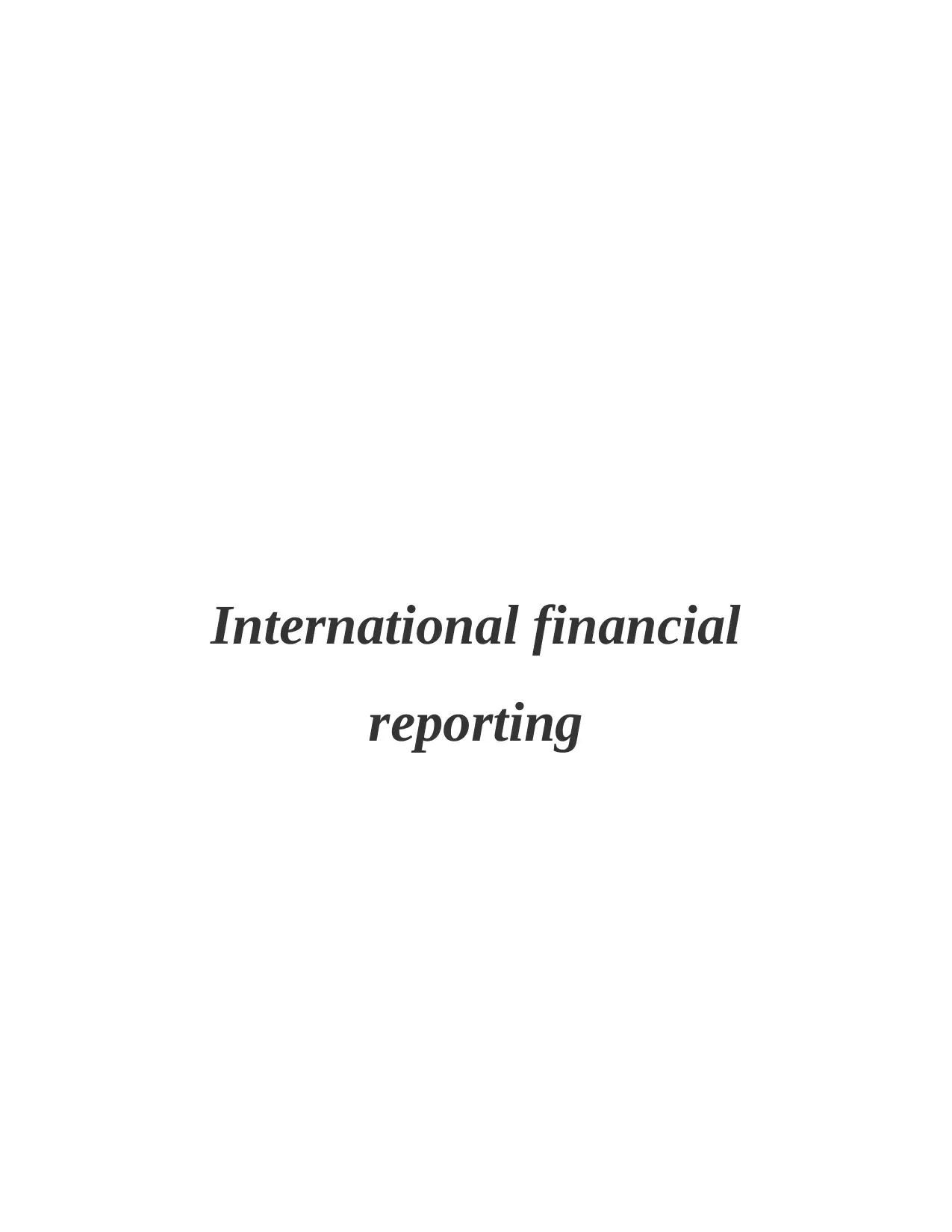
International financial
reporting
reporting
Paraphrase This Document
Need a fresh take? Get an instant paraphrase of this document with our AI Paraphraser
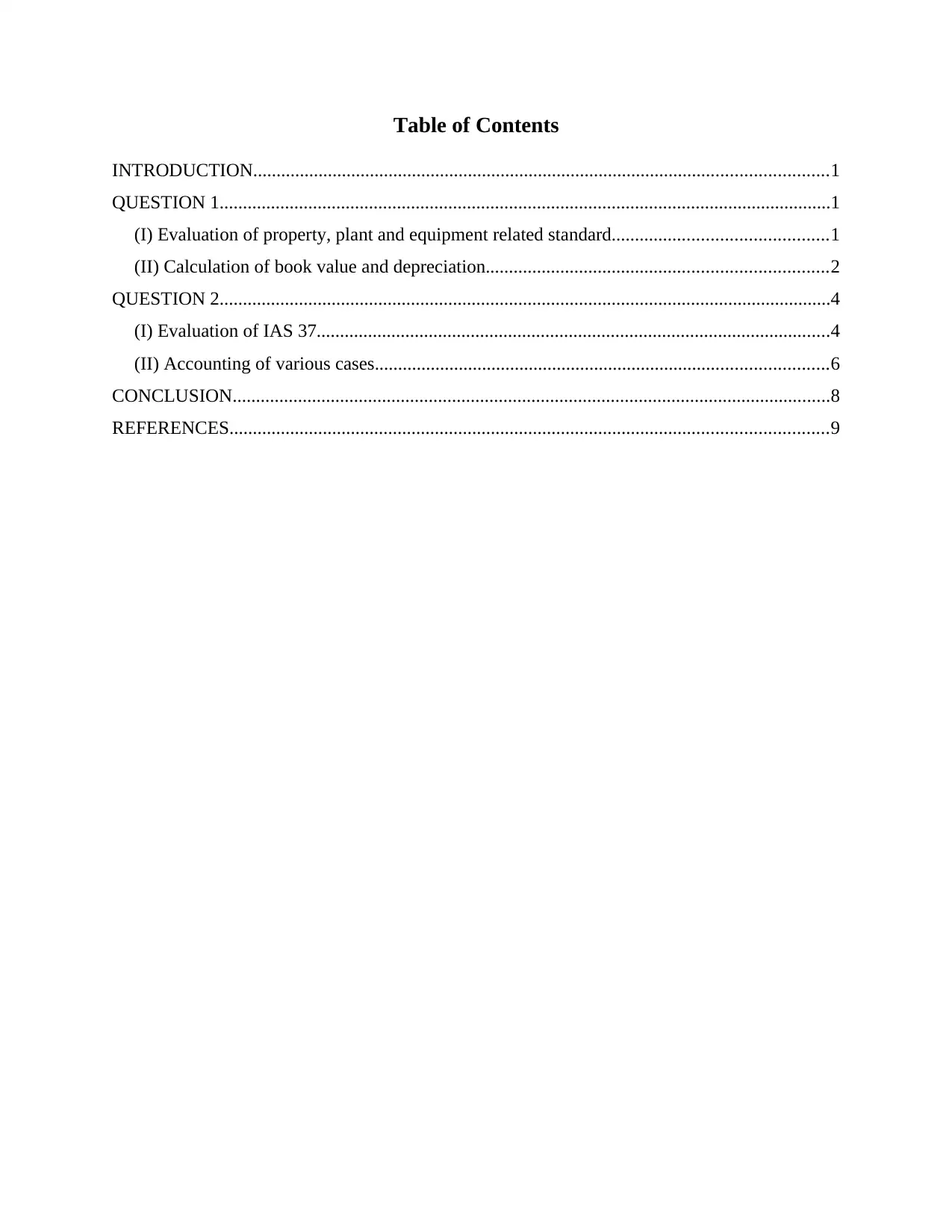
Table of Contents
INTRODUCTION...........................................................................................................................1
QUESTION 1...................................................................................................................................1
(I) Evaluation of property, plant and equipment related standard..............................................1
(II) Calculation of book value and depreciation.........................................................................2
QUESTION 2...................................................................................................................................4
(I) Evaluation of IAS 37..............................................................................................................4
(II) Accounting of various cases.................................................................................................6
CONCLUSION................................................................................................................................8
REFERENCES................................................................................................................................9
INTRODUCTION...........................................................................................................................1
QUESTION 1...................................................................................................................................1
(I) Evaluation of property, plant and equipment related standard..............................................1
(II) Calculation of book value and depreciation.........................................................................2
QUESTION 2...................................................................................................................................4
(I) Evaluation of IAS 37..............................................................................................................4
(II) Accounting of various cases.................................................................................................6
CONCLUSION................................................................................................................................8
REFERENCES................................................................................................................................9
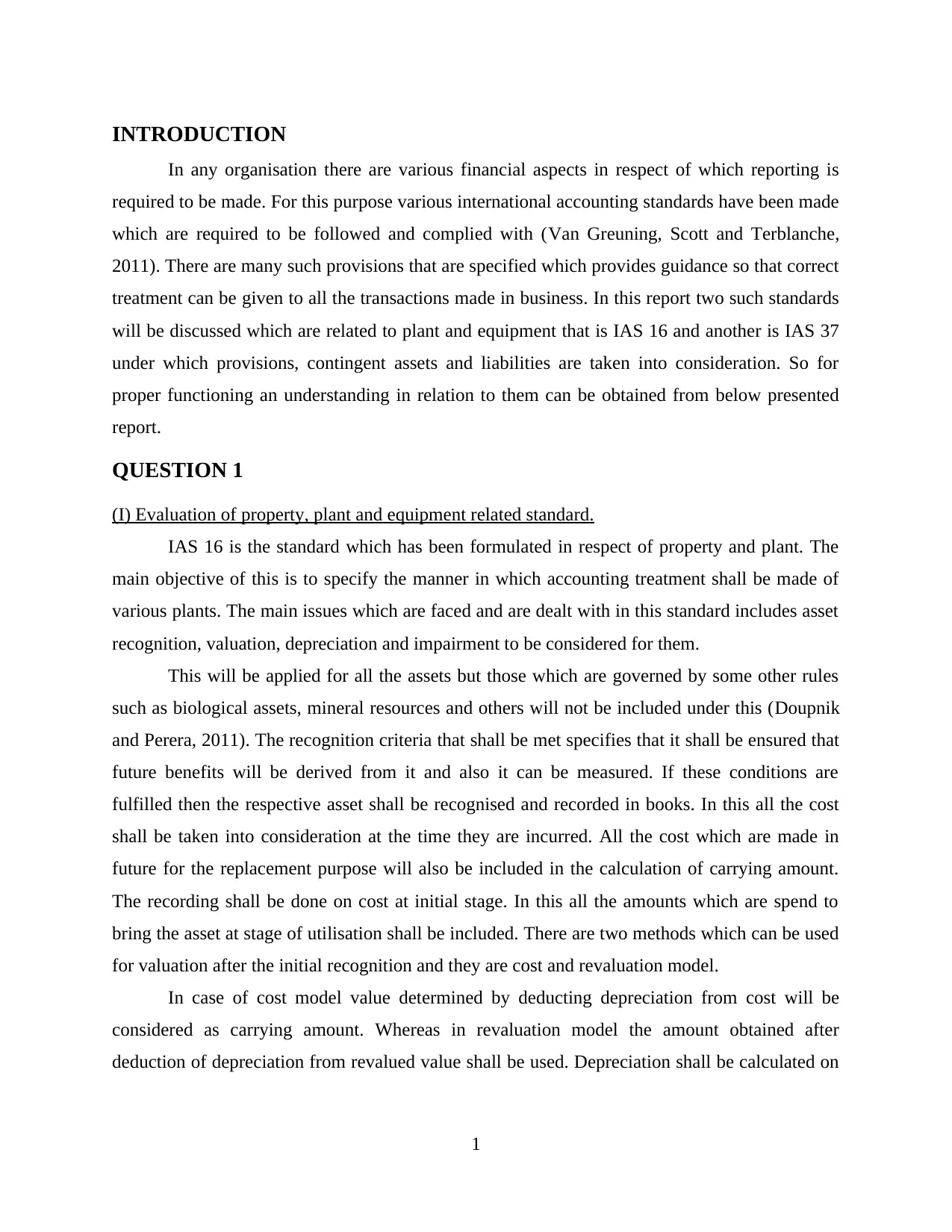
INTRODUCTION
In any organisation there are various financial aspects in respect of which reporting is
required to be made. For this purpose various international accounting standards have been made
which are required to be followed and complied with (Van Greuning, Scott and Terblanche,
2011). There are many such provisions that are specified which provides guidance so that correct
treatment can be given to all the transactions made in business. In this report two such standards
will be discussed which are related to plant and equipment that is IAS 16 and another is IAS 37
under which provisions, contingent assets and liabilities are taken into consideration. So for
proper functioning an understanding in relation to them can be obtained from below presented
report.
QUESTION 1
(I) Evaluation of property, plant and equipment related standard.
IAS 16 is the standard which has been formulated in respect of property and plant. The
main objective of this is to specify the manner in which accounting treatment shall be made of
various plants. The main issues which are faced and are dealt with in this standard includes asset
recognition, valuation, depreciation and impairment to be considered for them.
This will be applied for all the assets but those which are governed by some other rules
such as biological assets, mineral resources and others will not be included under this (Doupnik
and Perera, 2011). The recognition criteria that shall be met specifies that it shall be ensured that
future benefits will be derived from it and also it can be measured. If these conditions are
fulfilled then the respective asset shall be recognised and recorded in books. In this all the cost
shall be taken into consideration at the time they are incurred. All the cost which are made in
future for the replacement purpose will also be included in the calculation of carrying amount.
The recording shall be done on cost at initial stage. In this all the amounts which are spend to
bring the asset at stage of utilisation shall be included. There are two methods which can be used
for valuation after the initial recognition and they are cost and revaluation model.
In case of cost model value determined by deducting depreciation from cost will be
considered as carrying amount. Whereas in revaluation model the amount obtained after
deduction of depreciation from revalued value shall be used. Depreciation shall be calculated on
1
In any organisation there are various financial aspects in respect of which reporting is
required to be made. For this purpose various international accounting standards have been made
which are required to be followed and complied with (Van Greuning, Scott and Terblanche,
2011). There are many such provisions that are specified which provides guidance so that correct
treatment can be given to all the transactions made in business. In this report two such standards
will be discussed which are related to plant and equipment that is IAS 16 and another is IAS 37
under which provisions, contingent assets and liabilities are taken into consideration. So for
proper functioning an understanding in relation to them can be obtained from below presented
report.
QUESTION 1
(I) Evaluation of property, plant and equipment related standard.
IAS 16 is the standard which has been formulated in respect of property and plant. The
main objective of this is to specify the manner in which accounting treatment shall be made of
various plants. The main issues which are faced and are dealt with in this standard includes asset
recognition, valuation, depreciation and impairment to be considered for them.
This will be applied for all the assets but those which are governed by some other rules
such as biological assets, mineral resources and others will not be included under this (Doupnik
and Perera, 2011). The recognition criteria that shall be met specifies that it shall be ensured that
future benefits will be derived from it and also it can be measured. If these conditions are
fulfilled then the respective asset shall be recognised and recorded in books. In this all the cost
shall be taken into consideration at the time they are incurred. All the cost which are made in
future for the replacement purpose will also be included in the calculation of carrying amount.
The recording shall be done on cost at initial stage. In this all the amounts which are spend to
bring the asset at stage of utilisation shall be included. There are two methods which can be used
for valuation after the initial recognition and they are cost and revaluation model.
In case of cost model value determined by deducting depreciation from cost will be
considered as carrying amount. Whereas in revaluation model the amount obtained after
deduction of depreciation from revalued value shall be used. Depreciation shall be calculated on
1
⊘ This is a preview!⊘
Do you want full access?
Subscribe today to unlock all pages.

Trusted by 1+ million students worldwide
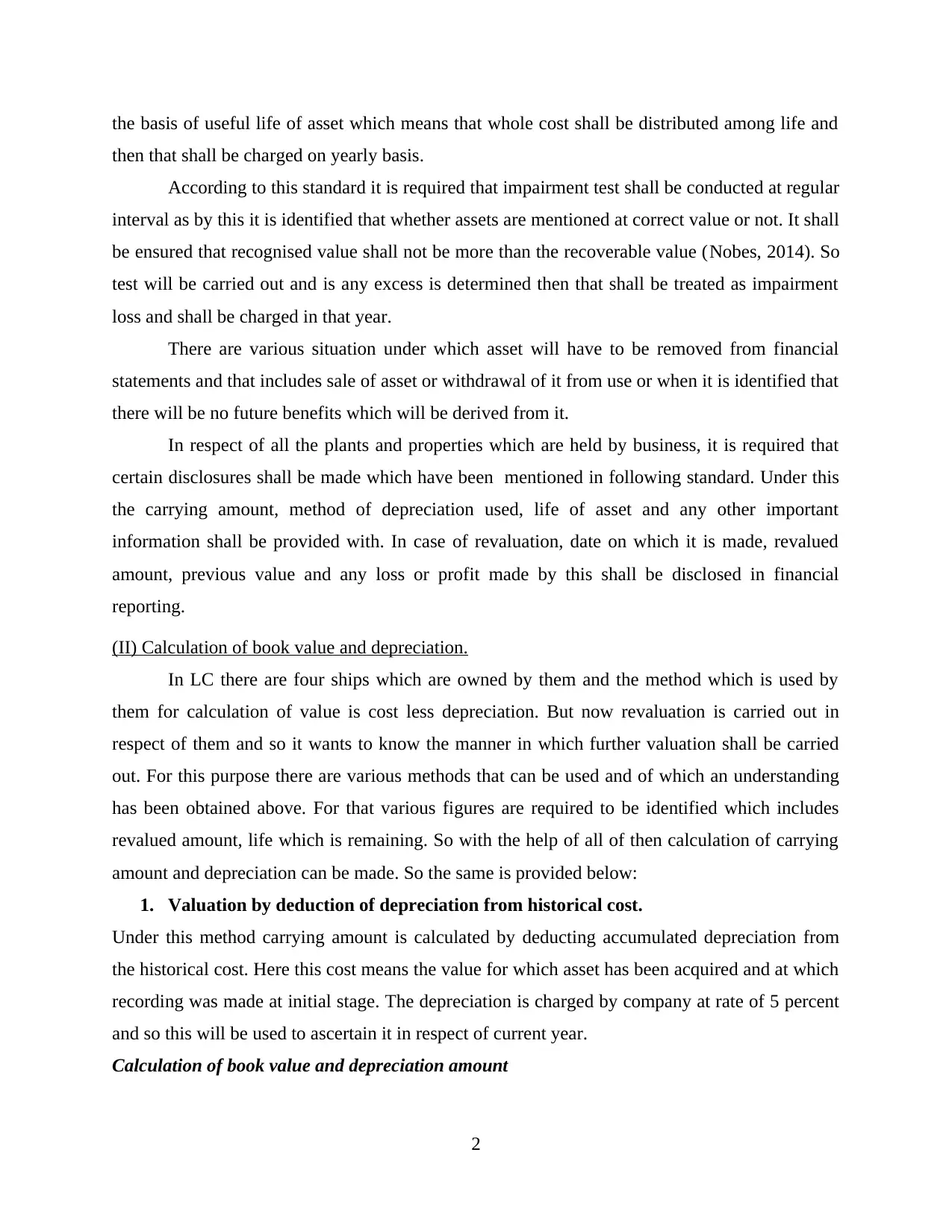
the basis of useful life of asset which means that whole cost shall be distributed among life and
then that shall be charged on yearly basis.
According to this standard it is required that impairment test shall be conducted at regular
interval as by this it is identified that whether assets are mentioned at correct value or not. It shall
be ensured that recognised value shall not be more than the recoverable value (Nobes, 2014). So
test will be carried out and is any excess is determined then that shall be treated as impairment
loss and shall be charged in that year.
There are various situation under which asset will have to be removed from financial
statements and that includes sale of asset or withdrawal of it from use or when it is identified that
there will be no future benefits which will be derived from it.
In respect of all the plants and properties which are held by business, it is required that
certain disclosures shall be made which have been mentioned in following standard. Under this
the carrying amount, method of depreciation used, life of asset and any other important
information shall be provided with. In case of revaluation, date on which it is made, revalued
amount, previous value and any loss or profit made by this shall be disclosed in financial
reporting.
(II) Calculation of book value and depreciation.
In LC there are four ships which are owned by them and the method which is used by
them for calculation of value is cost less depreciation. But now revaluation is carried out in
respect of them and so it wants to know the manner in which further valuation shall be carried
out. For this purpose there are various methods that can be used and of which an understanding
has been obtained above. For that various figures are required to be identified which includes
revalued amount, life which is remaining. So with the help of all of then calculation of carrying
amount and depreciation can be made. So the same is provided below:
1. Valuation by deduction of depreciation from historical cost.
Under this method carrying amount is calculated by deducting accumulated depreciation from
the historical cost. Here this cost means the value for which asset has been acquired and at which
recording was made at initial stage. The depreciation is charged by company at rate of 5 percent
and so this will be used to ascertain it in respect of current year.
Calculation of book value and depreciation amount
2
then that shall be charged on yearly basis.
According to this standard it is required that impairment test shall be conducted at regular
interval as by this it is identified that whether assets are mentioned at correct value or not. It shall
be ensured that recognised value shall not be more than the recoverable value (Nobes, 2014). So
test will be carried out and is any excess is determined then that shall be treated as impairment
loss and shall be charged in that year.
There are various situation under which asset will have to be removed from financial
statements and that includes sale of asset or withdrawal of it from use or when it is identified that
there will be no future benefits which will be derived from it.
In respect of all the plants and properties which are held by business, it is required that
certain disclosures shall be made which have been mentioned in following standard. Under this
the carrying amount, method of depreciation used, life of asset and any other important
information shall be provided with. In case of revaluation, date on which it is made, revalued
amount, previous value and any loss or profit made by this shall be disclosed in financial
reporting.
(II) Calculation of book value and depreciation.
In LC there are four ships which are owned by them and the method which is used by
them for calculation of value is cost less depreciation. But now revaluation is carried out in
respect of them and so it wants to know the manner in which further valuation shall be carried
out. For this purpose there are various methods that can be used and of which an understanding
has been obtained above. For that various figures are required to be identified which includes
revalued amount, life which is remaining. So with the help of all of then calculation of carrying
amount and depreciation can be made. So the same is provided below:
1. Valuation by deduction of depreciation from historical cost.
Under this method carrying amount is calculated by deducting accumulated depreciation from
the historical cost. Here this cost means the value for which asset has been acquired and at which
recording was made at initial stage. The depreciation is charged by company at rate of 5 percent
and so this will be used to ascertain it in respect of current year.
Calculation of book value and depreciation amount
2
Paraphrase This Document
Need a fresh take? Get an instant paraphrase of this document with our AI Paraphraser
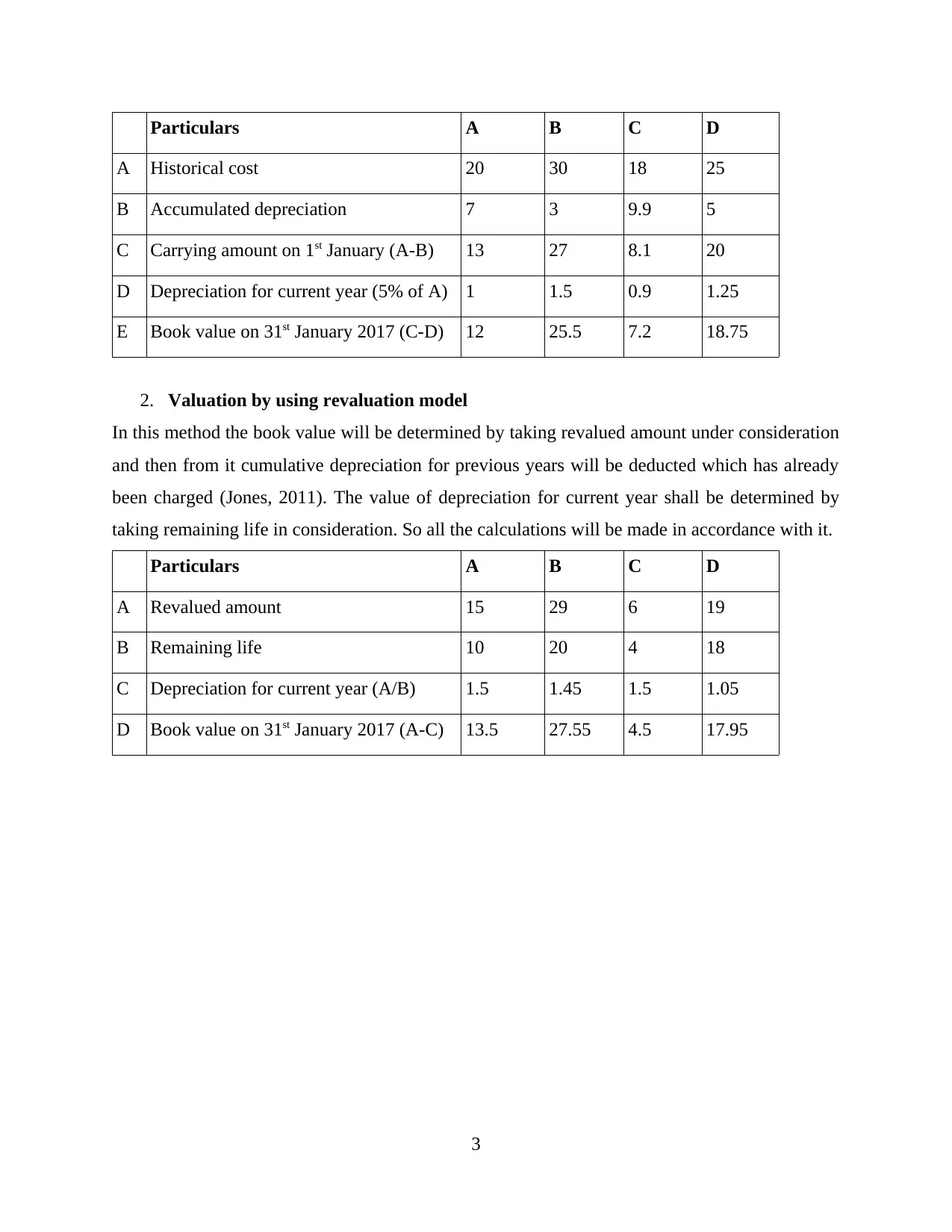
Particulars A B C D
A Historical cost 20 30 18 25
B Accumulated depreciation 7 3 9.9 5
C Carrying amount on 1st January (A-B) 13 27 8.1 20
D Depreciation for current year (5% of A) 1 1.5 0.9 1.25
E Book value on 31st January 2017 (C-D) 12 25.5 7.2 18.75
2. Valuation by using revaluation model
In this method the book value will be determined by taking revalued amount under consideration
and then from it cumulative depreciation for previous years will be deducted which has already
been charged (Jones, 2011). The value of depreciation for current year shall be determined by
taking remaining life in consideration. So all the calculations will be made in accordance with it.
Particulars A B C D
A Revalued amount 15 29 6 19
B Remaining life 10 20 4 18
C Depreciation for current year (A/B) 1.5 1.45 1.5 1.05
D Book value on 31st January 2017 (A-C) 13.5 27.55 4.5 17.95
3
A Historical cost 20 30 18 25
B Accumulated depreciation 7 3 9.9 5
C Carrying amount on 1st January (A-B) 13 27 8.1 20
D Depreciation for current year (5% of A) 1 1.5 0.9 1.25
E Book value on 31st January 2017 (C-D) 12 25.5 7.2 18.75
2. Valuation by using revaluation model
In this method the book value will be determined by taking revalued amount under consideration
and then from it cumulative depreciation for previous years will be deducted which has already
been charged (Jones, 2011). The value of depreciation for current year shall be determined by
taking remaining life in consideration. So all the calculations will be made in accordance with it.
Particulars A B C D
A Revalued amount 15 29 6 19
B Remaining life 10 20 4 18
C Depreciation for current year (A/B) 1.5 1.45 1.5 1.05
D Book value on 31st January 2017 (A-C) 13.5 27.55 4.5 17.95
3
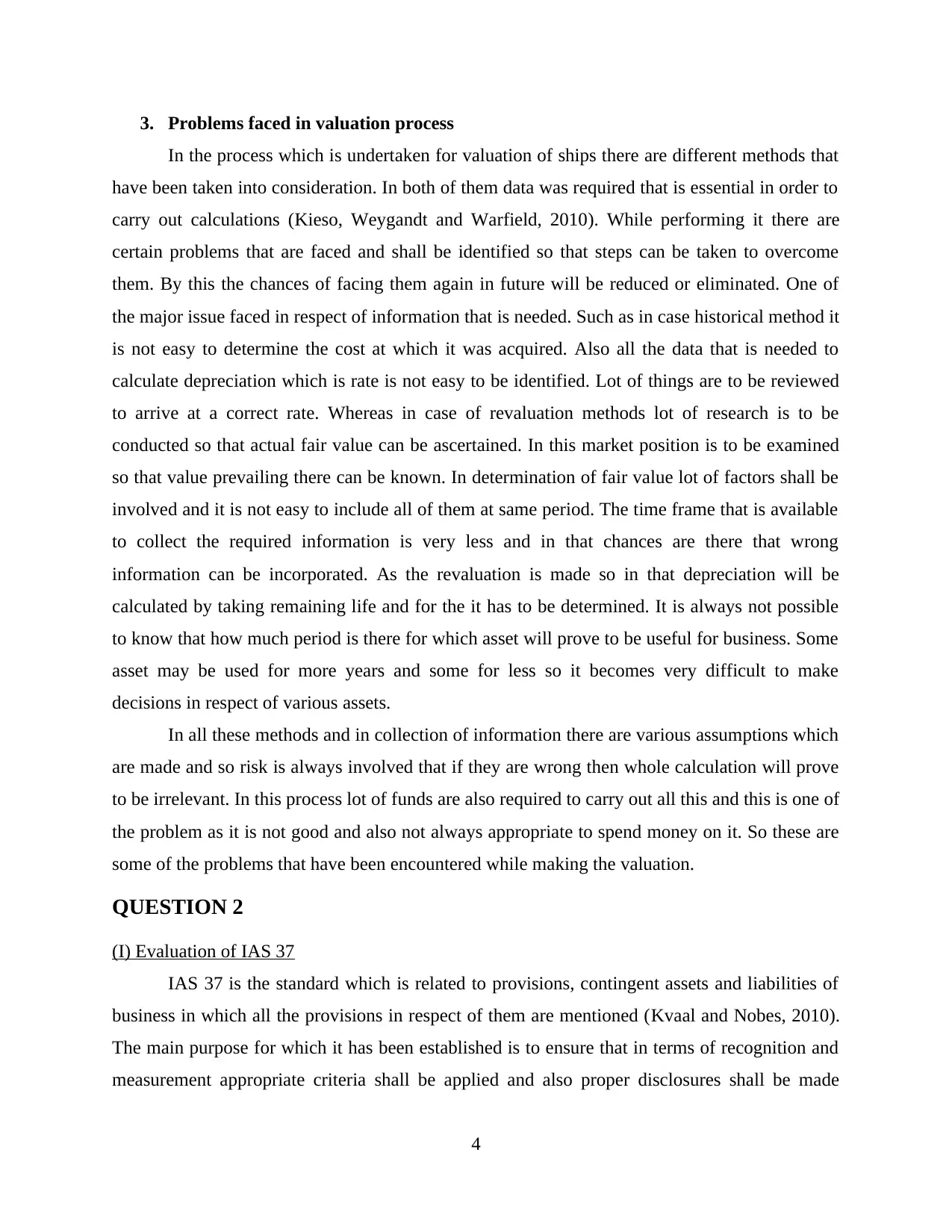
3. Problems faced in valuation process
In the process which is undertaken for valuation of ships there are different methods that
have been taken into consideration. In both of them data was required that is essential in order to
carry out calculations (Kieso, Weygandt and Warfield, 2010). While performing it there are
certain problems that are faced and shall be identified so that steps can be taken to overcome
them. By this the chances of facing them again in future will be reduced or eliminated. One of
the major issue faced in respect of information that is needed. Such as in case historical method it
is not easy to determine the cost at which it was acquired. Also all the data that is needed to
calculate depreciation which is rate is not easy to be identified. Lot of things are to be reviewed
to arrive at a correct rate. Whereas in case of revaluation methods lot of research is to be
conducted so that actual fair value can be ascertained. In this market position is to be examined
so that value prevailing there can be known. In determination of fair value lot of factors shall be
involved and it is not easy to include all of them at same period. The time frame that is available
to collect the required information is very less and in that chances are there that wrong
information can be incorporated. As the revaluation is made so in that depreciation will be
calculated by taking remaining life and for the it has to be determined. It is always not possible
to know that how much period is there for which asset will prove to be useful for business. Some
asset may be used for more years and some for less so it becomes very difficult to make
decisions in respect of various assets.
In all these methods and in collection of information there are various assumptions which
are made and so risk is always involved that if they are wrong then whole calculation will prove
to be irrelevant. In this process lot of funds are also required to carry out all this and this is one of
the problem as it is not good and also not always appropriate to spend money on it. So these are
some of the problems that have been encountered while making the valuation.
QUESTION 2
(I) Evaluation of IAS 37
IAS 37 is the standard which is related to provisions, contingent assets and liabilities of
business in which all the provisions in respect of them are mentioned (Kvaal and Nobes, 2010).
The main purpose for which it has been established is to ensure that in terms of recognition and
measurement appropriate criteria shall be applied and also proper disclosures shall be made
4
In the process which is undertaken for valuation of ships there are different methods that
have been taken into consideration. In both of them data was required that is essential in order to
carry out calculations (Kieso, Weygandt and Warfield, 2010). While performing it there are
certain problems that are faced and shall be identified so that steps can be taken to overcome
them. By this the chances of facing them again in future will be reduced or eliminated. One of
the major issue faced in respect of information that is needed. Such as in case historical method it
is not easy to determine the cost at which it was acquired. Also all the data that is needed to
calculate depreciation which is rate is not easy to be identified. Lot of things are to be reviewed
to arrive at a correct rate. Whereas in case of revaluation methods lot of research is to be
conducted so that actual fair value can be ascertained. In this market position is to be examined
so that value prevailing there can be known. In determination of fair value lot of factors shall be
involved and it is not easy to include all of them at same period. The time frame that is available
to collect the required information is very less and in that chances are there that wrong
information can be incorporated. As the revaluation is made so in that depreciation will be
calculated by taking remaining life and for the it has to be determined. It is always not possible
to know that how much period is there for which asset will prove to be useful for business. Some
asset may be used for more years and some for less so it becomes very difficult to make
decisions in respect of various assets.
In all these methods and in collection of information there are various assumptions which
are made and so risk is always involved that if they are wrong then whole calculation will prove
to be irrelevant. In this process lot of funds are also required to carry out all this and this is one of
the problem as it is not good and also not always appropriate to spend money on it. So these are
some of the problems that have been encountered while making the valuation.
QUESTION 2
(I) Evaluation of IAS 37
IAS 37 is the standard which is related to provisions, contingent assets and liabilities of
business in which all the provisions in respect of them are mentioned (Kvaal and Nobes, 2010).
The main purpose for which it has been established is to ensure that in terms of recognition and
measurement appropriate criteria shall be applied and also proper disclosures shall be made
4
⊘ This is a preview!⊘
Do you want full access?
Subscribe today to unlock all pages.

Trusted by 1+ million students worldwide
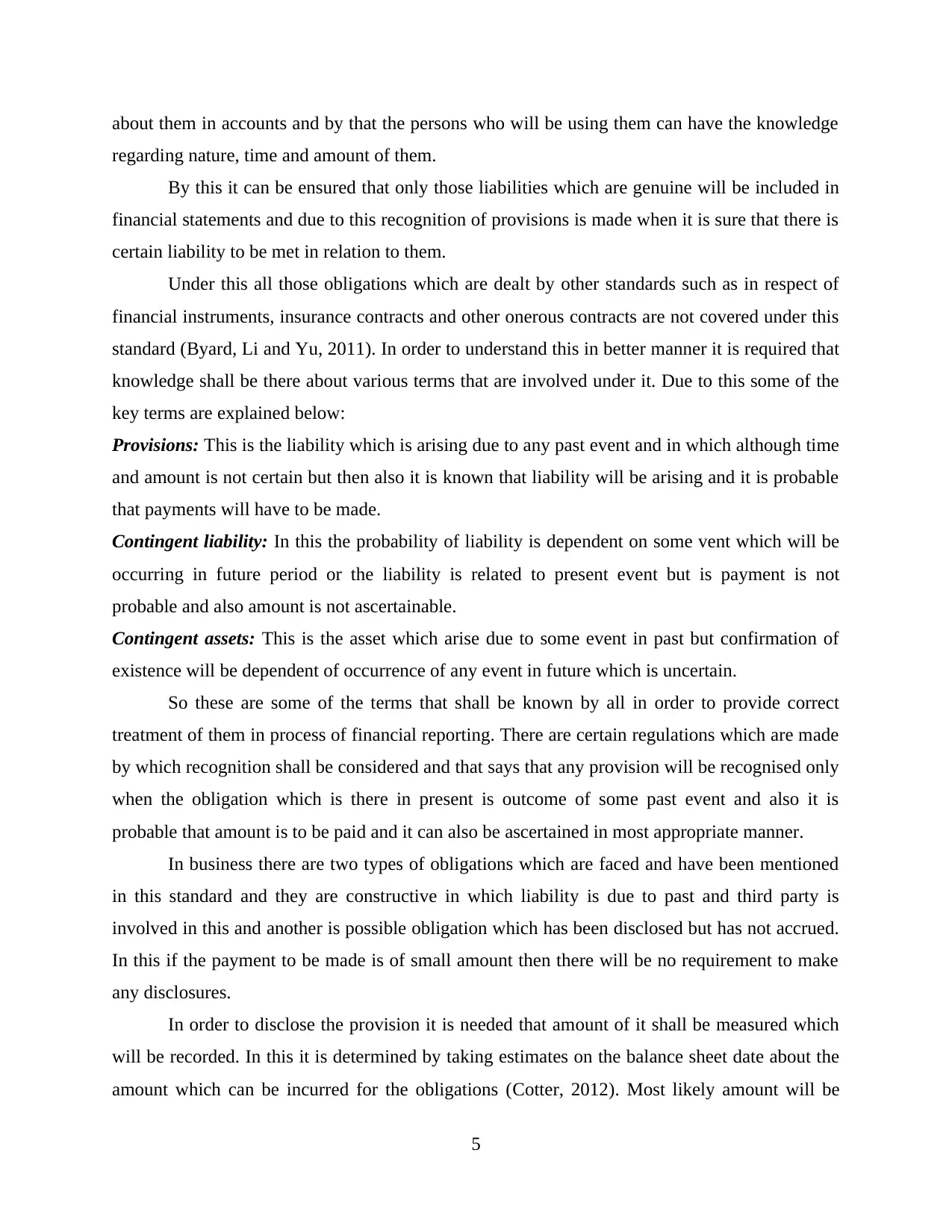
about them in accounts and by that the persons who will be using them can have the knowledge
regarding nature, time and amount of them.
By this it can be ensured that only those liabilities which are genuine will be included in
financial statements and due to this recognition of provisions is made when it is sure that there is
certain liability to be met in relation to them.
Under this all those obligations which are dealt by other standards such as in respect of
financial instruments, insurance contracts and other onerous contracts are not covered under this
standard (Byard, Li and Yu, 2011). In order to understand this in better manner it is required that
knowledge shall be there about various terms that are involved under it. Due to this some of the
key terms are explained below:
Provisions: This is the liability which is arising due to any past event and in which although time
and amount is not certain but then also it is known that liability will be arising and it is probable
that payments will have to be made.
Contingent liability: In this the probability of liability is dependent on some vent which will be
occurring in future period or the liability is related to present event but is payment is not
probable and also amount is not ascertainable.
Contingent assets: This is the asset which arise due to some event in past but confirmation of
existence will be dependent of occurrence of any event in future which is uncertain.
So these are some of the terms that shall be known by all in order to provide correct
treatment of them in process of financial reporting. There are certain regulations which are made
by which recognition shall be considered and that says that any provision will be recognised only
when the obligation which is there in present is outcome of some past event and also it is
probable that amount is to be paid and it can also be ascertained in most appropriate manner.
In business there are two types of obligations which are faced and have been mentioned
in this standard and they are constructive in which liability is due to past and third party is
involved in this and another is possible obligation which has been disclosed but has not accrued.
In this if the payment to be made is of small amount then there will be no requirement to make
any disclosures.
In order to disclose the provision it is needed that amount of it shall be measured which
will be recorded. In this it is determined by taking estimates on the balance sheet date about the
amount which can be incurred for the obligations (Cotter, 2012). Most likely amount will be
5
regarding nature, time and amount of them.
By this it can be ensured that only those liabilities which are genuine will be included in
financial statements and due to this recognition of provisions is made when it is sure that there is
certain liability to be met in relation to them.
Under this all those obligations which are dealt by other standards such as in respect of
financial instruments, insurance contracts and other onerous contracts are not covered under this
standard (Byard, Li and Yu, 2011). In order to understand this in better manner it is required that
knowledge shall be there about various terms that are involved under it. Due to this some of the
key terms are explained below:
Provisions: This is the liability which is arising due to any past event and in which although time
and amount is not certain but then also it is known that liability will be arising and it is probable
that payments will have to be made.
Contingent liability: In this the probability of liability is dependent on some vent which will be
occurring in future period or the liability is related to present event but is payment is not
probable and also amount is not ascertainable.
Contingent assets: This is the asset which arise due to some event in past but confirmation of
existence will be dependent of occurrence of any event in future which is uncertain.
So these are some of the terms that shall be known by all in order to provide correct
treatment of them in process of financial reporting. There are certain regulations which are made
by which recognition shall be considered and that says that any provision will be recognised only
when the obligation which is there in present is outcome of some past event and also it is
probable that amount is to be paid and it can also be ascertained in most appropriate manner.
In business there are two types of obligations which are faced and have been mentioned
in this standard and they are constructive in which liability is due to past and third party is
involved in this and another is possible obligation which has been disclosed but has not accrued.
In this if the payment to be made is of small amount then there will be no requirement to make
any disclosures.
In order to disclose the provision it is needed that amount of it shall be measured which
will be recorded. In this it is determined by taking estimates on the balance sheet date about the
amount which can be incurred for the obligations (Cotter, 2012). Most likely amount will be
5
Paraphrase This Document
Need a fresh take? Get an instant paraphrase of this document with our AI Paraphraser
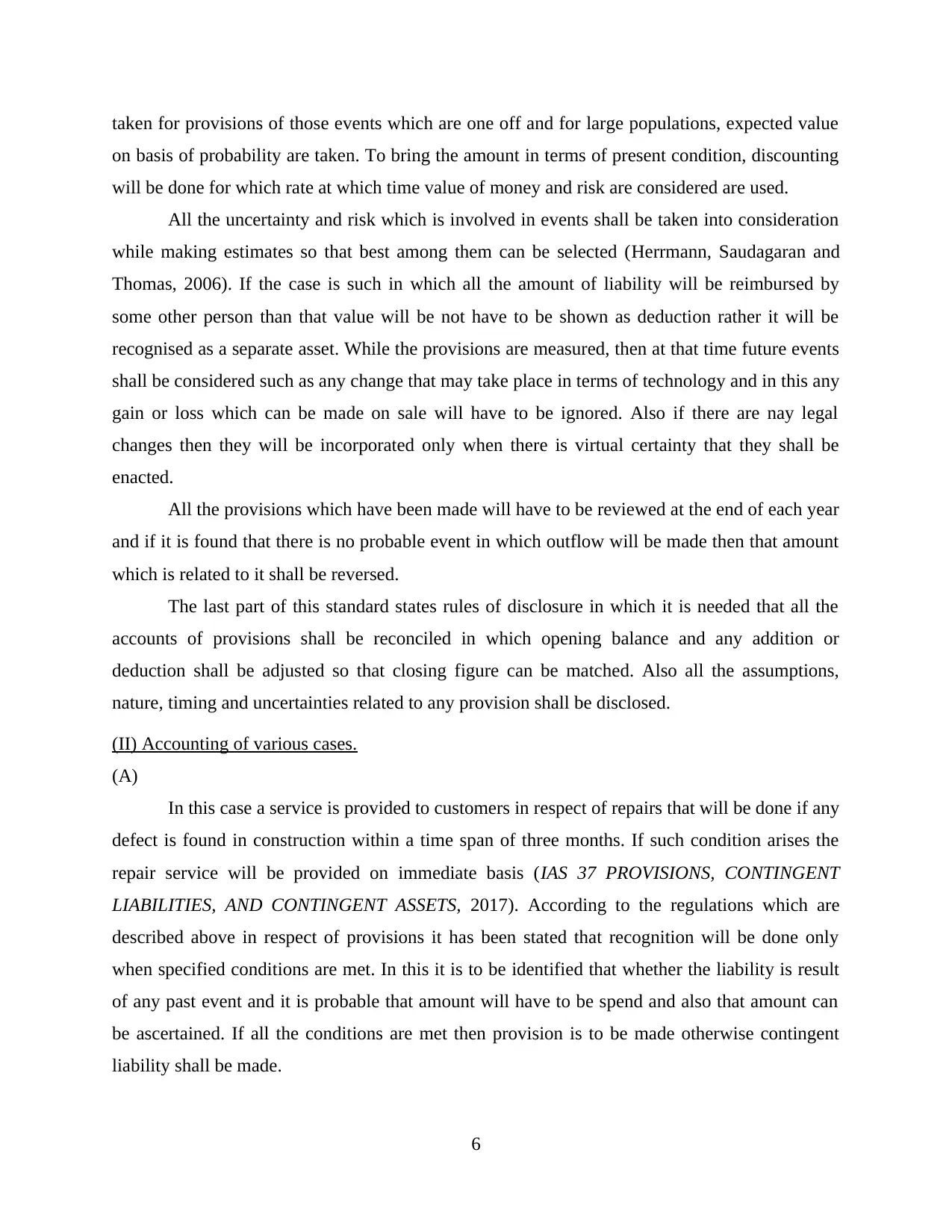
taken for provisions of those events which are one off and for large populations, expected value
on basis of probability are taken. To bring the amount in terms of present condition, discounting
will be done for which rate at which time value of money and risk are considered are used.
All the uncertainty and risk which is involved in events shall be taken into consideration
while making estimates so that best among them can be selected (Herrmann, Saudagaran and
Thomas, 2006). If the case is such in which all the amount of liability will be reimbursed by
some other person than that value will be not have to be shown as deduction rather it will be
recognised as a separate asset. While the provisions are measured, then at that time future events
shall be considered such as any change that may take place in terms of technology and in this any
gain or loss which can be made on sale will have to be ignored. Also if there are nay legal
changes then they will be incorporated only when there is virtual certainty that they shall be
enacted.
All the provisions which have been made will have to be reviewed at the end of each year
and if it is found that there is no probable event in which outflow will be made then that amount
which is related to it shall be reversed.
The last part of this standard states rules of disclosure in which it is needed that all the
accounts of provisions shall be reconciled in which opening balance and any addition or
deduction shall be adjusted so that closing figure can be matched. Also all the assumptions,
nature, timing and uncertainties related to any provision shall be disclosed.
(II) Accounting of various cases.
(A)
In this case a service is provided to customers in respect of repairs that will be done if any
defect is found in construction within a time span of three months. If such condition arises the
repair service will be provided on immediate basis (IAS 37 PROVISIONS, CONTINGENT
LIABILITIES, AND CONTINGENT ASSETS, 2017). According to the regulations which are
described above in respect of provisions it has been stated that recognition will be done only
when specified conditions are met. In this it is to be identified that whether the liability is result
of any past event and it is probable that amount will have to be spend and also that amount can
be ascertained. If all the conditions are met then provision is to be made otherwise contingent
liability shall be made.
6
on basis of probability are taken. To bring the amount in terms of present condition, discounting
will be done for which rate at which time value of money and risk are considered are used.
All the uncertainty and risk which is involved in events shall be taken into consideration
while making estimates so that best among them can be selected (Herrmann, Saudagaran and
Thomas, 2006). If the case is such in which all the amount of liability will be reimbursed by
some other person than that value will be not have to be shown as deduction rather it will be
recognised as a separate asset. While the provisions are measured, then at that time future events
shall be considered such as any change that may take place in terms of technology and in this any
gain or loss which can be made on sale will have to be ignored. Also if there are nay legal
changes then they will be incorporated only when there is virtual certainty that they shall be
enacted.
All the provisions which have been made will have to be reviewed at the end of each year
and if it is found that there is no probable event in which outflow will be made then that amount
which is related to it shall be reversed.
The last part of this standard states rules of disclosure in which it is needed that all the
accounts of provisions shall be reconciled in which opening balance and any addition or
deduction shall be adjusted so that closing figure can be matched. Also all the assumptions,
nature, timing and uncertainties related to any provision shall be disclosed.
(II) Accounting of various cases.
(A)
In this case a service is provided to customers in respect of repairs that will be done if any
defect is found in construction within a time span of three months. If such condition arises the
repair service will be provided on immediate basis (IAS 37 PROVISIONS, CONTINGENT
LIABILITIES, AND CONTINGENT ASSETS, 2017). According to the regulations which are
described above in respect of provisions it has been stated that recognition will be done only
when specified conditions are met. In this it is to be identified that whether the liability is result
of any past event and it is probable that amount will have to be spend and also that amount can
be ascertained. If all the conditions are met then provision is to be made otherwise contingent
liability shall be made.
6
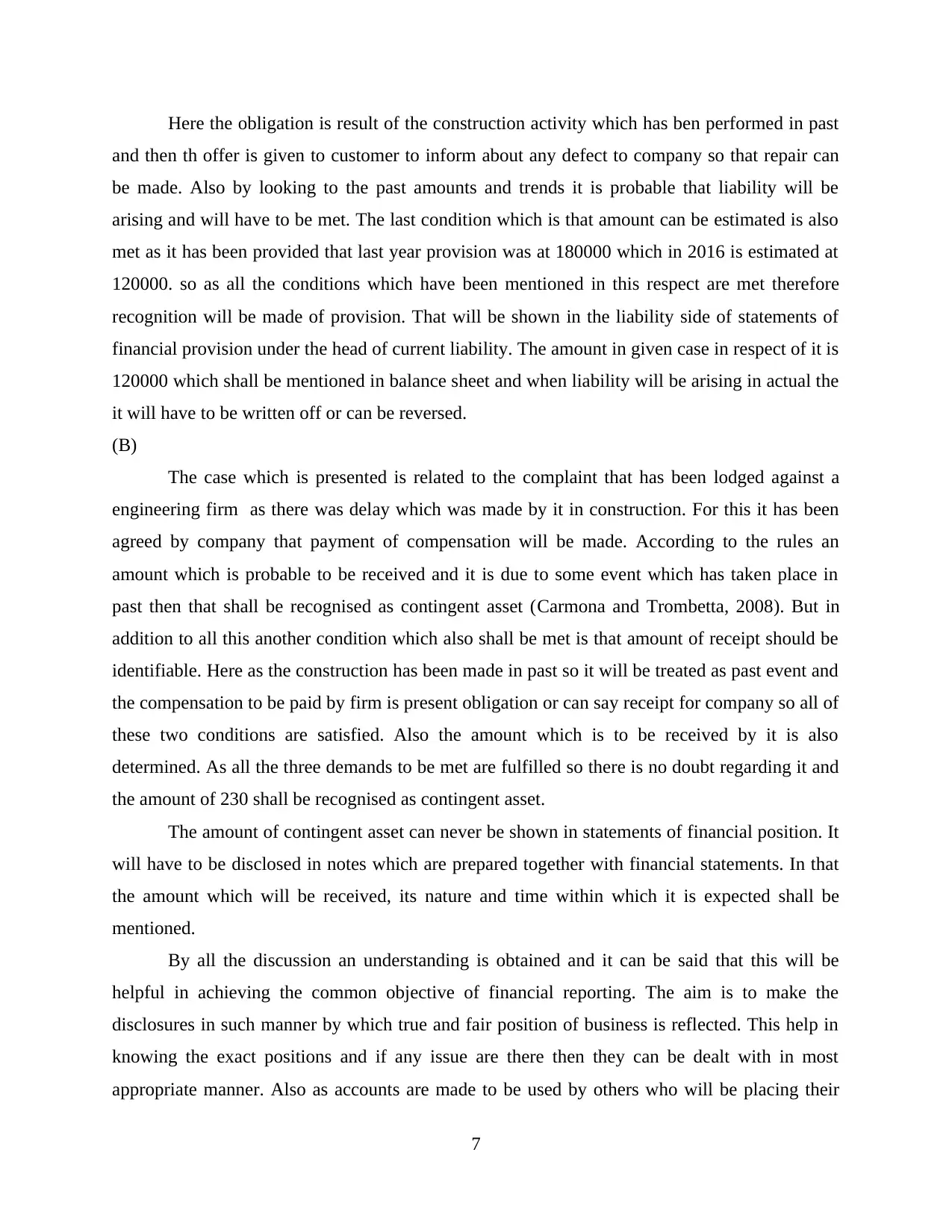
Here the obligation is result of the construction activity which has ben performed in past
and then th offer is given to customer to inform about any defect to company so that repair can
be made. Also by looking to the past amounts and trends it is probable that liability will be
arising and will have to be met. The last condition which is that amount can be estimated is also
met as it has been provided that last year provision was at 180000 which in 2016 is estimated at
120000. so as all the conditions which have been mentioned in this respect are met therefore
recognition will be made of provision. That will be shown in the liability side of statements of
financial provision under the head of current liability. The amount in given case in respect of it is
120000 which shall be mentioned in balance sheet and when liability will be arising in actual the
it will have to be written off or can be reversed.
(B)
The case which is presented is related to the complaint that has been lodged against a
engineering firm as there was delay which was made by it in construction. For this it has been
agreed by company that payment of compensation will be made. According to the rules an
amount which is probable to be received and it is due to some event which has taken place in
past then that shall be recognised as contingent asset (Carmona and Trombetta, 2008). But in
addition to all this another condition which also shall be met is that amount of receipt should be
identifiable. Here as the construction has been made in past so it will be treated as past event and
the compensation to be paid by firm is present obligation or can say receipt for company so all of
these two conditions are satisfied. Also the amount which is to be received by it is also
determined. As all the three demands to be met are fulfilled so there is no doubt regarding it and
the amount of 230 shall be recognised as contingent asset.
The amount of contingent asset can never be shown in statements of financial position. It
will have to be disclosed in notes which are prepared together with financial statements. In that
the amount which will be received, its nature and time within which it is expected shall be
mentioned.
By all the discussion an understanding is obtained and it can be said that this will be
helpful in achieving the common objective of financial reporting. The aim is to make the
disclosures in such manner by which true and fair position of business is reflected. This help in
knowing the exact positions and if any issue are there then they can be dealt with in most
appropriate manner. Also as accounts are made to be used by others who will be placing their
7
and then th offer is given to customer to inform about any defect to company so that repair can
be made. Also by looking to the past amounts and trends it is probable that liability will be
arising and will have to be met. The last condition which is that amount can be estimated is also
met as it has been provided that last year provision was at 180000 which in 2016 is estimated at
120000. so as all the conditions which have been mentioned in this respect are met therefore
recognition will be made of provision. That will be shown in the liability side of statements of
financial provision under the head of current liability. The amount in given case in respect of it is
120000 which shall be mentioned in balance sheet and when liability will be arising in actual the
it will have to be written off or can be reversed.
(B)
The case which is presented is related to the complaint that has been lodged against a
engineering firm as there was delay which was made by it in construction. For this it has been
agreed by company that payment of compensation will be made. According to the rules an
amount which is probable to be received and it is due to some event which has taken place in
past then that shall be recognised as contingent asset (Carmona and Trombetta, 2008). But in
addition to all this another condition which also shall be met is that amount of receipt should be
identifiable. Here as the construction has been made in past so it will be treated as past event and
the compensation to be paid by firm is present obligation or can say receipt for company so all of
these two conditions are satisfied. Also the amount which is to be received by it is also
determined. As all the three demands to be met are fulfilled so there is no doubt regarding it and
the amount of 230 shall be recognised as contingent asset.
The amount of contingent asset can never be shown in statements of financial position. It
will have to be disclosed in notes which are prepared together with financial statements. In that
the amount which will be received, its nature and time within which it is expected shall be
mentioned.
By all the discussion an understanding is obtained and it can be said that this will be
helpful in achieving the common objective of financial reporting. The aim is to make the
disclosures in such manner by which true and fair position of business is reflected. This help in
knowing the exact positions and if any issue are there then they can be dealt with in most
appropriate manner. Also as accounts are made to be used by others who will be placing their
7
⊘ This is a preview!⊘
Do you want full access?
Subscribe today to unlock all pages.

Trusted by 1+ million students worldwide
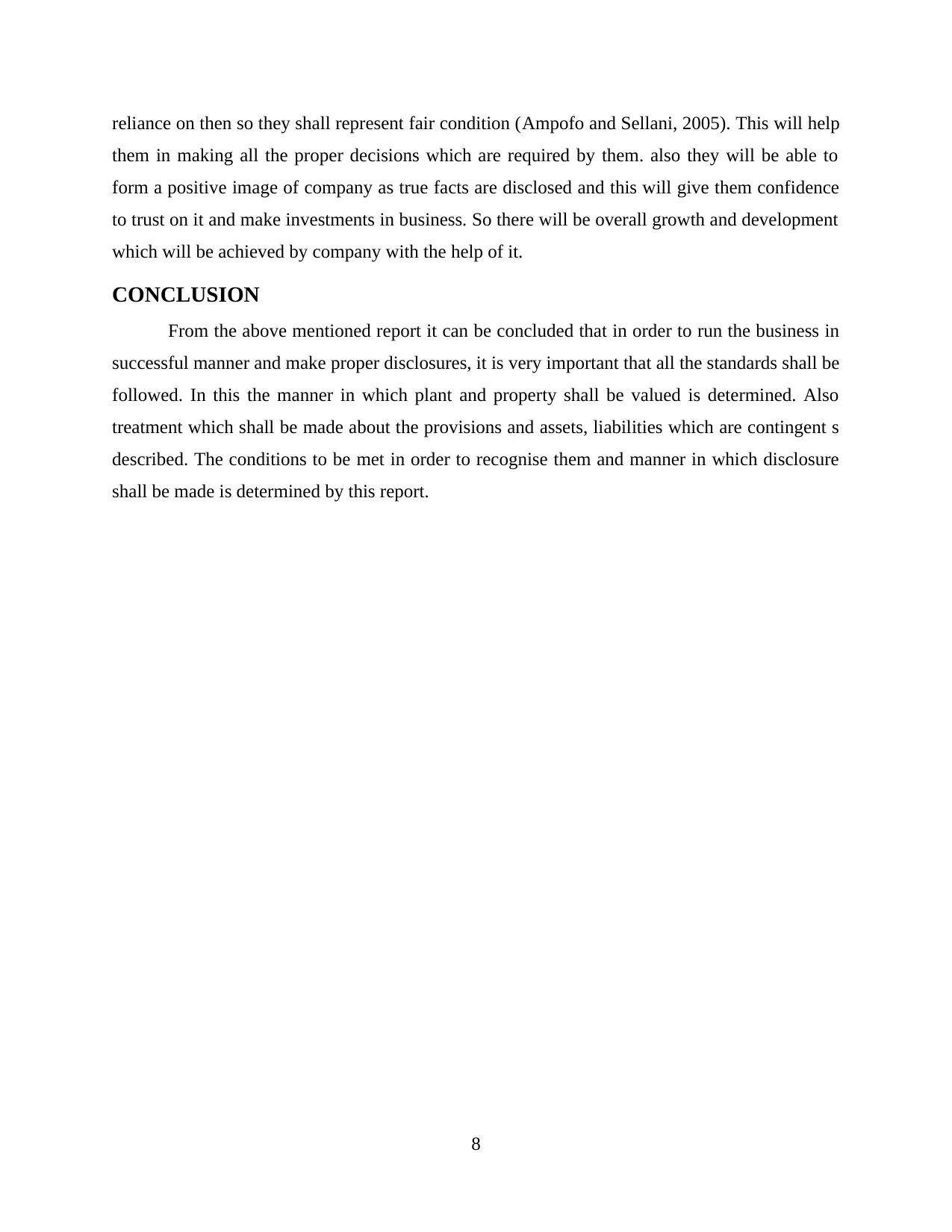
reliance on then so they shall represent fair condition (Ampofo and Sellani, 2005). This will help
them in making all the proper decisions which are required by them. also they will be able to
form a positive image of company as true facts are disclosed and this will give them confidence
to trust on it and make investments in business. So there will be overall growth and development
which will be achieved by company with the help of it.
CONCLUSION
From the above mentioned report it can be concluded that in order to run the business in
successful manner and make proper disclosures, it is very important that all the standards shall be
followed. In this the manner in which plant and property shall be valued is determined. Also
treatment which shall be made about the provisions and assets, liabilities which are contingent s
described. The conditions to be met in order to recognise them and manner in which disclosure
shall be made is determined by this report.
8
them in making all the proper decisions which are required by them. also they will be able to
form a positive image of company as true facts are disclosed and this will give them confidence
to trust on it and make investments in business. So there will be overall growth and development
which will be achieved by company with the help of it.
CONCLUSION
From the above mentioned report it can be concluded that in order to run the business in
successful manner and make proper disclosures, it is very important that all the standards shall be
followed. In this the manner in which plant and property shall be valued is determined. Also
treatment which shall be made about the provisions and assets, liabilities which are contingent s
described. The conditions to be met in order to recognise them and manner in which disclosure
shall be made is determined by this report.
8
Paraphrase This Document
Need a fresh take? Get an instant paraphrase of this document with our AI Paraphraser
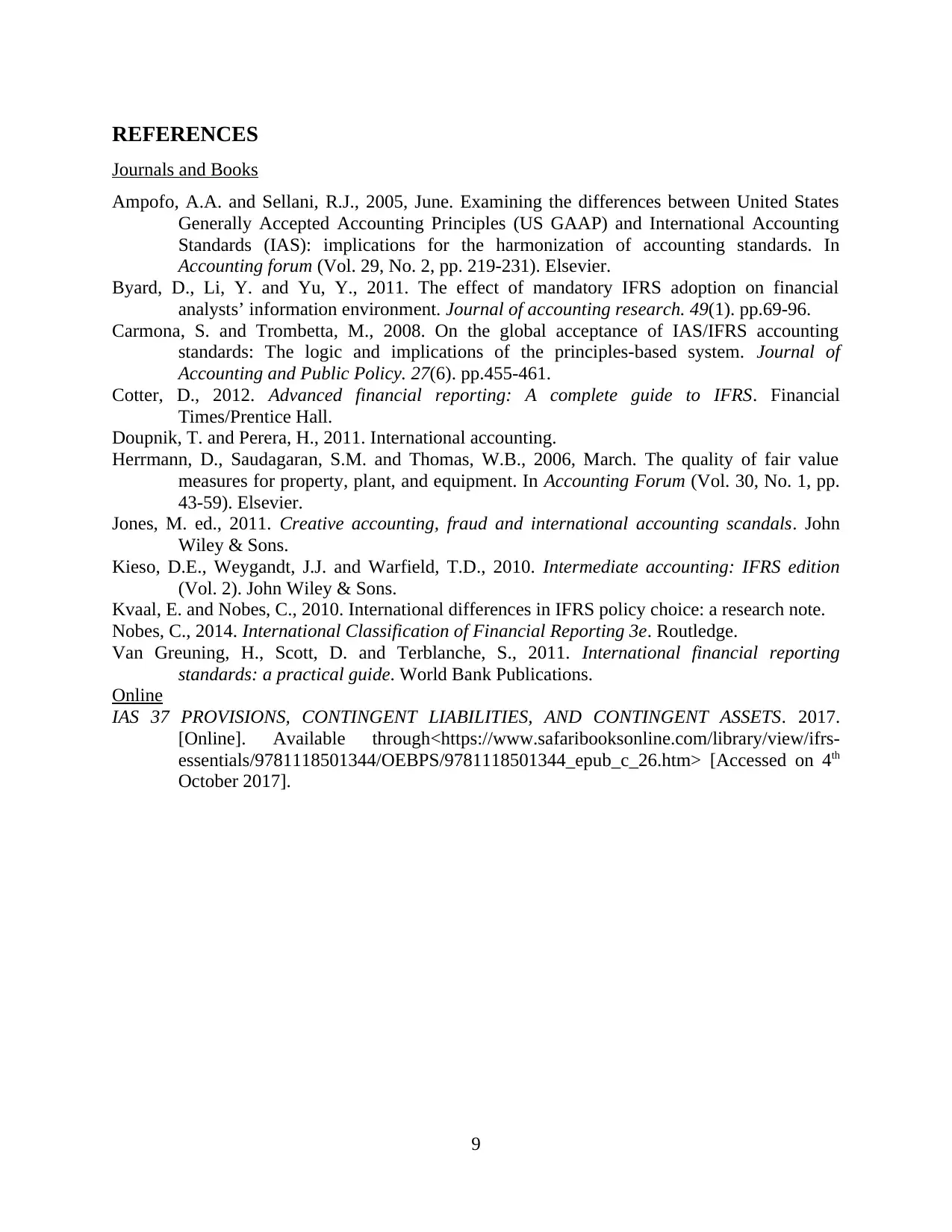
REFERENCES
Journals and Books
Ampofo, A.A. and Sellani, R.J., 2005, June. Examining the differences between United States
Generally Accepted Accounting Principles (US GAAP) and International Accounting
Standards (IAS): implications for the harmonization of accounting standards. In
Accounting forum (Vol. 29, No. 2, pp. 219-231). Elsevier.
Byard, D., Li, Y. and Yu, Y., 2011. The effect of mandatory IFRS adoption on financial
analysts’ information environment. Journal of accounting research. 49(1). pp.69-96.
Carmona, S. and Trombetta, M., 2008. On the global acceptance of IAS/IFRS accounting
standards: The logic and implications of the principles-based system. Journal of
Accounting and Public Policy. 27(6). pp.455-461.
Cotter, D., 2012. Advanced financial reporting: A complete guide to IFRS. Financial
Times/Prentice Hall.
Doupnik, T. and Perera, H., 2011. International accounting.
Herrmann, D., Saudagaran, S.M. and Thomas, W.B., 2006, March. The quality of fair value
measures for property, plant, and equipment. In Accounting Forum (Vol. 30, No. 1, pp.
43-59). Elsevier.
Jones, M. ed., 2011. Creative accounting, fraud and international accounting scandals. John
Wiley & Sons.
Kieso, D.E., Weygandt, J.J. and Warfield, T.D., 2010. Intermediate accounting: IFRS edition
(Vol. 2). John Wiley & Sons.
Kvaal, E. and Nobes, C., 2010. International differences in IFRS policy choice: a research note.
Nobes, C., 2014. International Classification of Financial Reporting 3e. Routledge.
Van Greuning, H., Scott, D. and Terblanche, S., 2011. International financial reporting
standards: a practical guide. World Bank Publications.
Online
IAS 37 PROVISIONS, CONTINGENT LIABILITIES, AND CONTINGENT ASSETS. 2017.
[Online]. Available through<https://www.safaribooksonline.com/library/view/ifrs-
essentials/9781118501344/OEBPS/9781118501344_epub_c_26.htm> [Accessed on 4th
October 2017].
9
Journals and Books
Ampofo, A.A. and Sellani, R.J., 2005, June. Examining the differences between United States
Generally Accepted Accounting Principles (US GAAP) and International Accounting
Standards (IAS): implications for the harmonization of accounting standards. In
Accounting forum (Vol. 29, No. 2, pp. 219-231). Elsevier.
Byard, D., Li, Y. and Yu, Y., 2011. The effect of mandatory IFRS adoption on financial
analysts’ information environment. Journal of accounting research. 49(1). pp.69-96.
Carmona, S. and Trombetta, M., 2008. On the global acceptance of IAS/IFRS accounting
standards: The logic and implications of the principles-based system. Journal of
Accounting and Public Policy. 27(6). pp.455-461.
Cotter, D., 2012. Advanced financial reporting: A complete guide to IFRS. Financial
Times/Prentice Hall.
Doupnik, T. and Perera, H., 2011. International accounting.
Herrmann, D., Saudagaran, S.M. and Thomas, W.B., 2006, March. The quality of fair value
measures for property, plant, and equipment. In Accounting Forum (Vol. 30, No. 1, pp.
43-59). Elsevier.
Jones, M. ed., 2011. Creative accounting, fraud and international accounting scandals. John
Wiley & Sons.
Kieso, D.E., Weygandt, J.J. and Warfield, T.D., 2010. Intermediate accounting: IFRS edition
(Vol. 2). John Wiley & Sons.
Kvaal, E. and Nobes, C., 2010. International differences in IFRS policy choice: a research note.
Nobes, C., 2014. International Classification of Financial Reporting 3e. Routledge.
Van Greuning, H., Scott, D. and Terblanche, S., 2011. International financial reporting
standards: a practical guide. World Bank Publications.
Online
IAS 37 PROVISIONS, CONTINGENT LIABILITIES, AND CONTINGENT ASSETS. 2017.
[Online]. Available through<https://www.safaribooksonline.com/library/view/ifrs-
essentials/9781118501344/OEBPS/9781118501344_epub_c_26.htm> [Accessed on 4th
October 2017].
9

10
⊘ This is a preview!⊘
Do you want full access?
Subscribe today to unlock all pages.

Trusted by 1+ million students worldwide
1 out of 13
Related Documents
Your All-in-One AI-Powered Toolkit for Academic Success.
+13062052269
info@desklib.com
Available 24*7 on WhatsApp / Email
![[object Object]](/_next/static/media/star-bottom.7253800d.svg)
Unlock your academic potential
Copyright © 2020–2025 A2Z Services. All Rights Reserved. Developed and managed by ZUCOL.




